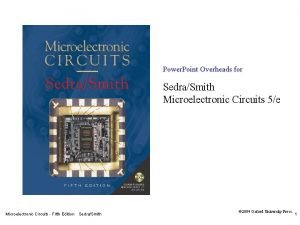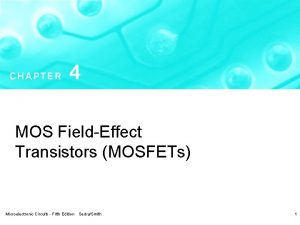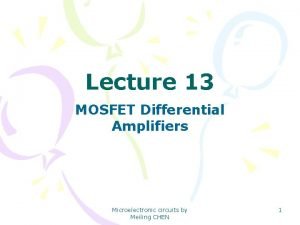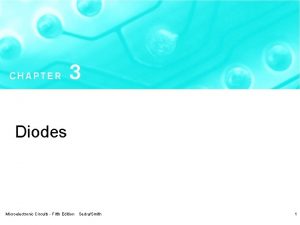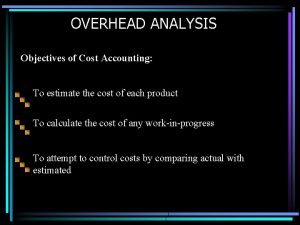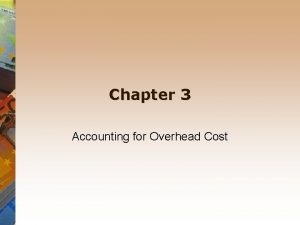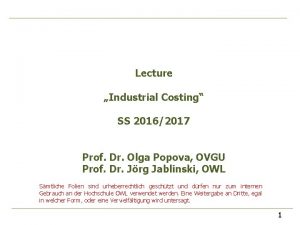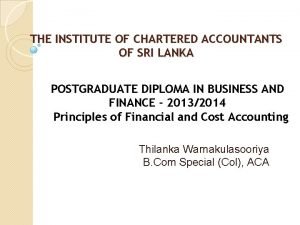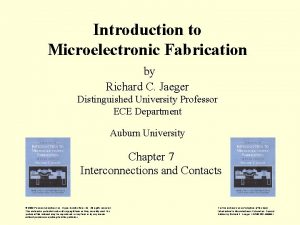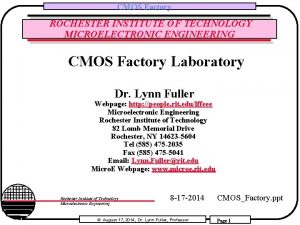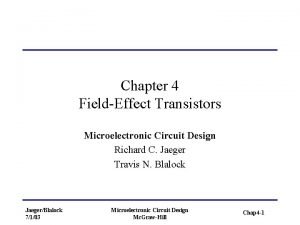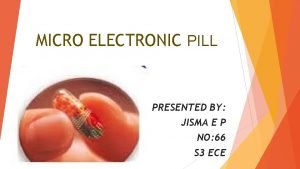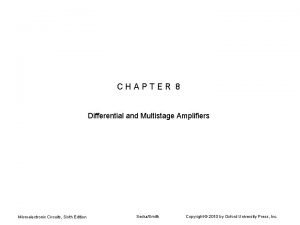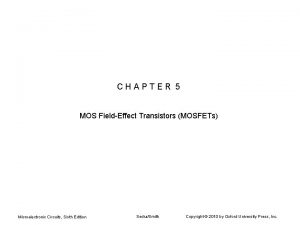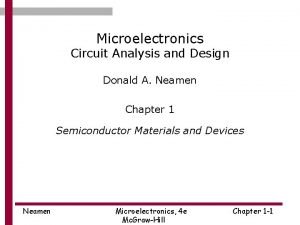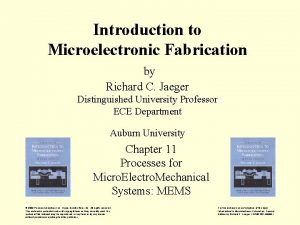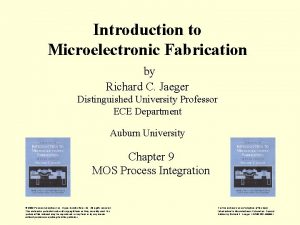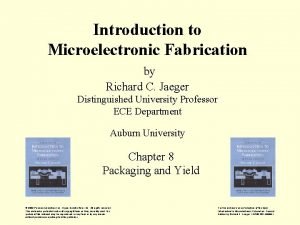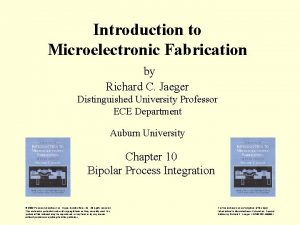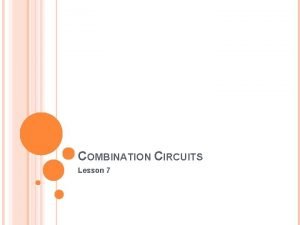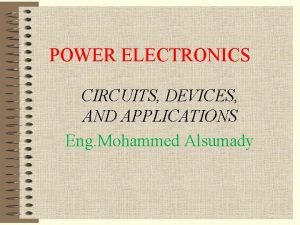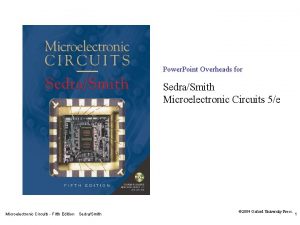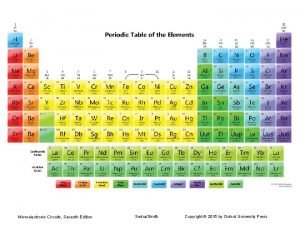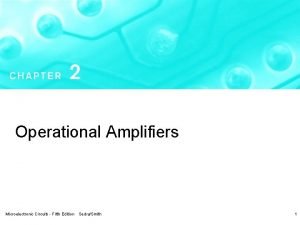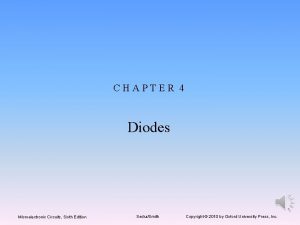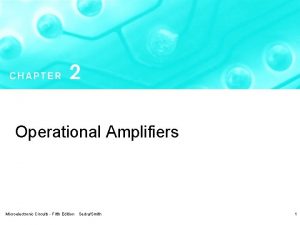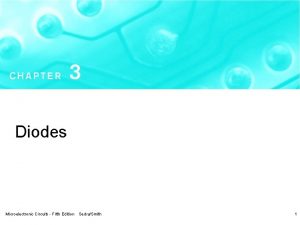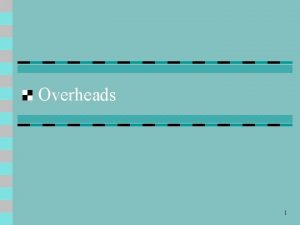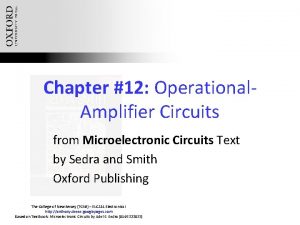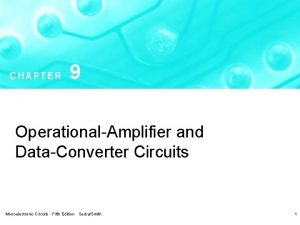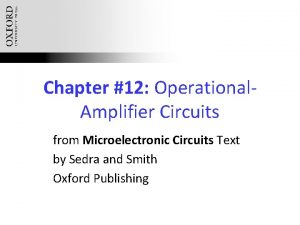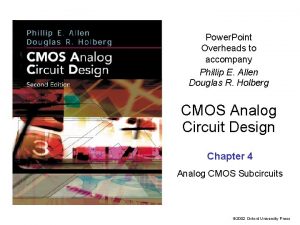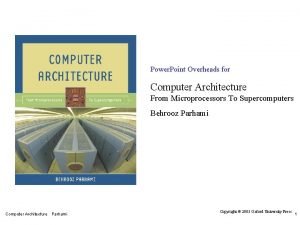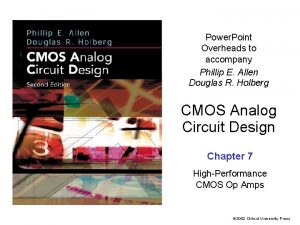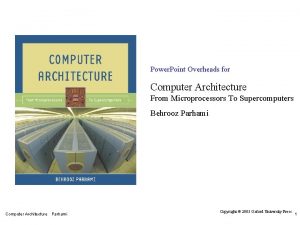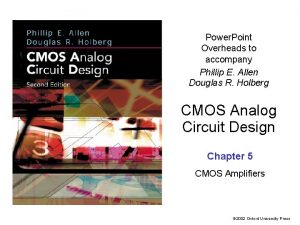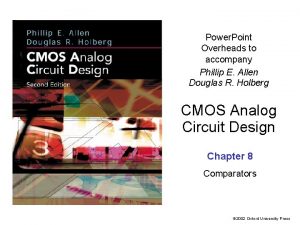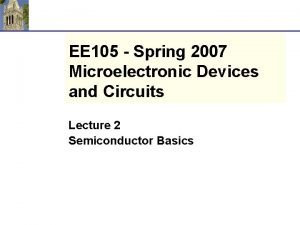Power Point Overheads for SedraSmith Microelectronic Circuits 5e


























































- Slides: 58

Power. Point Overheads for Sedra/Smith Microelectronic Circuits 5/e Microelectronic Circuits - Fifth Edition Sedra/Smith © 2004 Oxford University Press. 1

Oxford University Press Oxford New York Auckland Bangkok Buenos Aires Cape Town Chennai Dar es Salaam Delhi Hong Kong Istanbul Karachi Kolkata Kuala Lumpur Madrid Melbourne Mexico City Mumbai Nairobi São Paulo Shanghai Taipei Tokyo Toronto Copyright 2004 by Oxford University Press, Inc. Published by Oxford University Press, Inc. 198 Madison Avenue, New York 10016 www. oup. com Oxford is a registered trademark of Oxford University Press All rights reserved. No part of this publication may be reproduced, stored in a retrieval system, or transmitted, in any form or by any means, electronic, mechanical, photocopying, recording, or otherwise, without the prior permission of Oxford University Press. ISBN 0– 19– 517267– 1 Printing number: 9 8 7 6 5 4 3 2 1 Printed in the United States of America Microelectronic Circuits - Fifth Edition Sedra/Smith 2

Introduction to Electronics Microelectronic Circuits - Fifth Edition Sedra/Smith 3

Figure 1. 1 Two alternative representations of a signal source: (a) the Thévenin form, and (b) the Norton form. Microelectronic Circuits - Fifth Edition Sedra/Smith Copyright 2004 by Oxford University Press, Inc. 4

Figure 1. 2 An arbitrary voltage signal vs(t). Microelectronic Circuits - Fifth Edition Sedra/Smith Copyright 2004 by Oxford University Press, Inc. 5

Figure 1. 3 Sine-wave voltage signal of amplitude Va and frequency f = 1/T Hz. The angular frequency = 2 p f rad/s. Microelectronic Circuits - Fifth Edition Sedra/Smith Copyright 2004 by Oxford University Press, Inc. 6

Figure 1. 4 A symmetrical square-wave signal of amplitude V. Microelectronic Circuits - Fifth Edition Sedra/Smith Copyright 2004 by Oxford University Press, Inc. 7

Figure 1. 5 The frequency spectrum (also known as the line spectrum) of the periodic square wave of Fig. 1. 4. Microelectronic Circuits - Fifth Edition Sedra/Smith Copyright 2004 by Oxford University Press, Inc. 8

Figure 1. 6 The frequency spectrum of an arbitrary waveform such as that in Fig. 1. 2. Microelectronic Circuits - Fifth Edition Sedra/Smith Copyright 2004 by Oxford University Press, Inc. 9

Figure 1. 7 Sampling the continuous-time analog signal in (a) results in the discrete-time signal in (b). Microelectronic Circuits - Fifth Edition Sedra/Smith Copyright 2004 by Oxford University Press, Inc. 10

Figure 1. 8 Variation of a particular binary digital signal with time. Microelectronic Circuits - Fifth Edition Sedra/Smith Copyright 2004 by Oxford University Press, Inc. 11

Figure 1. 9 Block-diagram representation of the analog-to-digital converter (ADC). Microelectronic Circuits - Fifth Edition Sedra/Smith Copyright 2004 by Oxford University Press, Inc. 12

Figure 1. 10 (a) Circuit symbol for amplifier. (b) An amplifier with a common terminal (ground) between the input and output ports. Microelectronic Circuits - Fifth Edition Sedra/Smith Copyright 2004 by Oxford University Press, Inc. 13

Figure 1. 11 (a) A voltage amplifier fed with a signal v. I(t) and connected to a load resistance RL. (b) Transfer characteristic of a linear voltage amplifier with voltage gain Av. Microelectronic Circuits - Fifth Edition Sedra/Smith Copyright 2004 by Oxford University Press, Inc. 14

Figure 1. 12 An amplifier that requires two dc supplies (shown as batteries) for operation. Microelectronic Circuits - Fifth Edition Sedra/Smith Copyright 2004 by Oxford University Press, Inc. 15

Figure 1. 13 An amplifier transfer characteristic that is linear except for output saturation. Microelectronic Circuits - Fifth Edition Sedra/Smith Copyright 2004 by Oxford University Press, Inc. 16

Figure 1. 14 (a) An amplifier transfer characteristic that shows considerable nonlinearity. (b) To obtain linear operation the amplifier is biased as shown, and the signal amplitude is kept small. Observe that this amplifier is operated from a single power supply, VDD. Microelectronic Circuits - Fifth Edition Sedra/Smith Copyright 2004 by Oxford University Press, Inc. 17

Figure 1. 15 A sketch of the transfer characteristic of the amplifier of Example 1. 2. Note that this amplifier is inverting (i. e. , with a gain that is negative). Microelectronic Circuits - Fifth Edition Sedra/Smith Copyright 2004 by Oxford University Press, Inc. 18

Figure 1. 16 Symbol convention employed throughout the book. Microelectronic Circuits - Fifth Edition Sedra/Smith Copyright 2004 by Oxford University Press, Inc. 19

Figure 1. 17 (a) Circuit model for the voltage amplifier. (b) The voltage amplifier with input signal source and load. Microelectronic Circuits - Fifth Edition Sedra/Smith Copyright 2004 by Oxford University Press, Inc. 20

Figure 1. 18 Three-stage amplifier for Example 1. 3. Microelectronic Circuits - Fifth Edition Sedra/Smith Copyright 2004 by Oxford University Press, Inc. 21

Figure 1. 19 (a) Small-signal circuit model for a bipolar junction transistor (BJT). (b) The BJT connected as an amplifier with the emitter as a common terminal between input and output (called a common-emitter amplifier). (c) An alternative small-signal circuit model for the BJT. Microelectronic Circuits - Fifth Edition Sedra/Smith Copyright 2004 by Oxford University Press, Inc. 22

Figure E 1. 20 Microelectronic Circuits - Fifth Edition Sedra/Smith Copyright 2004 by Oxford University Press, Inc. 23

Figure 1. 20 Measuring the frequency response of a linear amplifier. At the test frequency v, the amplifier gain is characterized by its magnitude (Vo/Vi) and phase f. Microelectronic Circuits - Fifth Edition Sedra/Smith Copyright 2004 by Oxford University Press, Inc. 24

Figure 1. 21 Typical magnitude response of an amplifier. |T(v)| is the magnitude of the amplifier transfer function—that is, the ratio of the output Vo(v) to the input Vi(v). Microelectronic Circuits - Fifth Edition Sedra/Smith Copyright 2004 by Oxford University Press, Inc. 25

Figure 1. 22 Two examples of STC networks: (a) a low-pass network and (b) a high-pass network. Microelectronic Circuits - Fifth Edition Sedra/Smith Copyright 2004 by Oxford University Press, Inc. 26

Figure 1. 23 (a) Magnitude and (b) phase response of STC networks of the low-pass type. Microelectronic Circuits - Fifth Edition Sedra/Smith Copyright 2004 by Oxford University Press, Inc. 27

Figure 1. 24 (a) Magnitude and (b) phase response of STC networks of the high-pass type. Microelectronic Circuits - Fifth Edition Sedra/Smith Copyright 2004 by Oxford University Press, Inc. 28

Figure 1. 25 Circuit for Example 1. 5. Microelectronic Circuits - Fifth Edition Sedra/Smith Copyright 2004 by Oxford University Press, Inc. 29

Bode Plot – E 1. 5 Microelectronic Circuits - Fifth Edition Sedra/Smith Copyright 2004 by Oxford University Press, Inc. 30

Figure 1. 26 Frequency response for (a) a capacitively coupled amplifier, (b) a direct-coupled amplifier, and (c) a tuned or bandpass amplifier. Microelectronic Circuits - Fifth Edition Sedra/Smith Copyright 2004 by Oxford University Press, Inc. 31

Figure 1. 27 Use of a capacitor to couple amplifier stages. Microelectronic Circuits - Fifth Edition Sedra/Smith Copyright 2004 by Oxford University Press, Inc. 32

Figure E 1. 23 Microelectronic Circuits - Fifth Edition Sedra/Smith Copyright 2004 by Oxford University Press, Inc. 33

Figure 1. 28 A logic inverter operating from a dc supply VDD. Microelectronic Circuits - Fifth Edition Sedra/Smith Copyright 2004 by Oxford University Press, Inc. 34

Figure 1. 29 Voltage transfer characteristic of an inverter. The VTC is approximated by three straightline segments. Note the four parameters of the VTC (VOH, VOL, VIL, and VIH) and their use in determining the noise margins (NMH and NML). Microelectronic Circuits - Fifth Edition Sedra/Smith Copyright 2004 by Oxford University Press, Inc. 35

Figure 1. 30 The VTC of an ideal inverter. Microelectronic Circuits - Fifth Edition Sedra/Smith Copyright 2004 by Oxford University Press, Inc. 36

Figure 1. 31 (a) The simplest implementation of a logic inverter using a voltage-controlled switch; (b) equivalent circuit when v. I is low; and (c) equivalent circuit when v. I is high. Note that the switch is assumed to close when v. I is high. Microelectronic Circuits - Fifth Edition Sedra/Smith Copyright 2004 by Oxford University Press, Inc. 37

Figure 1. 32 A more elaborate implementation of the logic inverter utilizing two complementary switches. This is the basis of the CMOS inverter studied in Section 4. 10. Microelectronic Circuits - Fifth Edition Sedra/Smith Copyright 2004 by Oxford University Press, Inc. 38

Figure 1. 33 Another inverter implementation utilizing a double-throw switch to steer the constant current IEE to RC 1 (when v. I is high) or RC 2 (when v. I is low). This is the basis of the emitter-coupled logic (ECL) studied in Chapters 7 and 11. Microelectronic Circuits - Fifth Edition Sedra/Smith Copyright 2004 by Oxford University Press, Inc. 39

Figure 1. 34 Example 1. 6: (a) The inverter circuit after the switch opens (i. e. , for t 0 ). (b) Waveforms of v. I and v. O. Observe that the switch is assumed to operate instantaneously. v. O rises exponentially, starting at VOL and heading toward VOH. Microelectronic Circuits - Fifth Edition Sedra/Smith Copyright 2004 by Oxford University Press, Inc. 40

Figure 1. 35 Definitions of propagation delays and transition times of the logic inverter. Microelectronic Circuits - Fifth Edition Sedra/Smith Copyright 2004 by Oxford University Press, Inc. 41

Figure P 1. 6 Microelectronic Circuits - Fifth Edition Sedra/Smith Copyright 2004 by Oxford University Press, Inc. 42

Figure P 1. 10 Microelectronic Circuits - Fifth Edition Sedra/Smith Copyright 2004 by Oxford University Press, Inc. 43

Figure P 1. 14 Microelectronic Circuits - Fifth Edition Sedra/Smith Copyright 2004 by Oxford University Press, Inc. 44

Figure P 1. 15 Microelectronic Circuits - Fifth Edition Sedra/Smith Copyright 2004 by Oxford University Press, Inc. 45

Figure P 1. 16 Microelectronic Circuits - Fifth Edition Sedra/Smith Copyright 2004 by Oxford University Press, Inc. 46

Figure P 1. 17 Microelectronic Circuits - Fifth Edition Sedra/Smith Copyright 2004 by Oxford University Press, Inc. 47

Figure P 1. 18 Microelectronic Circuits - Fifth Edition Sedra/Smith Copyright 2004 by Oxford University Press, Inc. 48

Figure P 1. 37 Microelectronic Circuits - Fifth Edition Sedra/Smith Copyright 2004 by Oxford University Press, Inc. 49

Figure P 1. 58 Microelectronic Circuits - Fifth Edition Sedra/Smith Copyright 2004 by Oxford University Press, Inc. 50

Figure P 1. 63 Microelectronic Circuits - Fifth Edition Sedra/Smith Copyright 2004 by Oxford University Press, Inc. 51

Figure P 1. 65 Microelectronic Circuits - Fifth Edition Sedra/Smith Copyright 2004 by Oxford University Press, Inc. 52

Figure P 1. 67 Microelectronic Circuits - Fifth Edition Sedra/Smith Copyright 2004 by Oxford University Press, Inc. 53

Figure P 1. 68 Microelectronic Circuits - Fifth Edition Sedra/Smith Copyright 2004 by Oxford University Press, Inc. 54

Figure P 1. 72 Microelectronic Circuits - Fifth Edition Sedra/Smith Copyright 2004 by Oxford University Press, Inc. 55

Figure P 1. 77 Microelectronic Circuits - Fifth Edition Sedra/Smith Copyright 2004 by Oxford University Press, Inc. 56

Figure P 1. 79 Microelectronic Circuits - Fifth Edition Sedra/Smith Copyright 2004 by Oxford University Press, Inc. 57

Table 1. 1 The Four Amplifier Types Microelectronic Circuits - Fifth Edition Sedra/Smith Copyright 2004 by Oxford University Press, Inc. 58
 Sedrasmith
Sedrasmith Microelectronic circuits
Microelectronic circuits Microelectronic circuits
Microelectronic circuits Microelectronic circuits
Microelectronic circuits Advantages of parallel circuit over series circuit
Advantages of parallel circuit over series circuit Recovery of overheads
Recovery of overheads Supplementary rate in overheads
Supplementary rate in overheads Overhead cost per unit formula
Overhead cost per unit formula Primary distribution of overheads
Primary distribution of overheads Classification of overhead
Classification of overhead Overhead allocation and apportionment
Overhead allocation and apportionment Introduction to microelectronic fabrication
Introduction to microelectronic fabrication Rit microelectronic engineering
Rit microelectronic engineering Technology nodes
Technology nodes Microelectronic pills
Microelectronic pills Differential and multistage amplifiers
Differential and multistage amplifiers Microelectronic
Microelectronic Donald a neamen
Donald a neamen Introduction to microelectronic fabrication
Introduction to microelectronic fabrication Introduction to microelectronic fabrication
Introduction to microelectronic fabrication Introduction to microelectronic fabrication jaeger 1990
Introduction to microelectronic fabrication jaeger 1990 Introduction to microelectronic fabrication jaeger 1990
Introduction to microelectronic fabrication jaeger 1990 Power triangle
Power triangle Power bi training powerpoint
Power bi training powerpoint Point point power
Point point power Power management integrated circuits
Power management integrated circuits Lesson 4: how to calculate power in dc combination circuits
Lesson 4: how to calculate power in dc combination circuits Power electronics circuits devices and applications
Power electronics circuits devices and applications Iso 22301 utbildning
Iso 22301 utbildning Typiska drag för en novell
Typiska drag för en novell Tack för att ni lyssnade bild
Tack för att ni lyssnade bild Vad står k.r.å.k.a.n för
Vad står k.r.å.k.a.n för Shingelfrisyren
Shingelfrisyren En lathund för arbete med kontinuitetshantering
En lathund för arbete med kontinuitetshantering Särskild löneskatt för pensionskostnader
Särskild löneskatt för pensionskostnader Tidböcker
Tidböcker Anatomi organ reproduksi
Anatomi organ reproduksi Vad är densitet
Vad är densitet Datorkunskap för nybörjare
Datorkunskap för nybörjare Boverket ka
Boverket ka Hur skriver man en tes
Hur skriver man en tes Autokratiskt ledarskap
Autokratiskt ledarskap Nyckelkompetenser för livslångt lärande
Nyckelkompetenser för livslångt lärande Påbyggnader för flakfordon
Påbyggnader för flakfordon Lufttryck formel
Lufttryck formel Publik sektor
Publik sektor I gullregnens månad
I gullregnens månad Presentera för publik crossboss
Presentera för publik crossboss Argument för teckenspråk som minoritetsspråk
Argument för teckenspråk som minoritetsspråk Plats för toran ark
Plats för toran ark Treserva lathund
Treserva lathund Fimbrietratt
Fimbrietratt Claes martinsson
Claes martinsson Centrum för kunskap och säkerhet
Centrum för kunskap och säkerhet Verifikationsplan
Verifikationsplan Bra mat för unga idrottare
Bra mat för unga idrottare Verktyg för automatisering av utbetalningar
Verktyg för automatisering av utbetalningar Rutin för avvikelsehantering
Rutin för avvikelsehantering Smärtskolan kunskap för livet
Smärtskolan kunskap för livet
